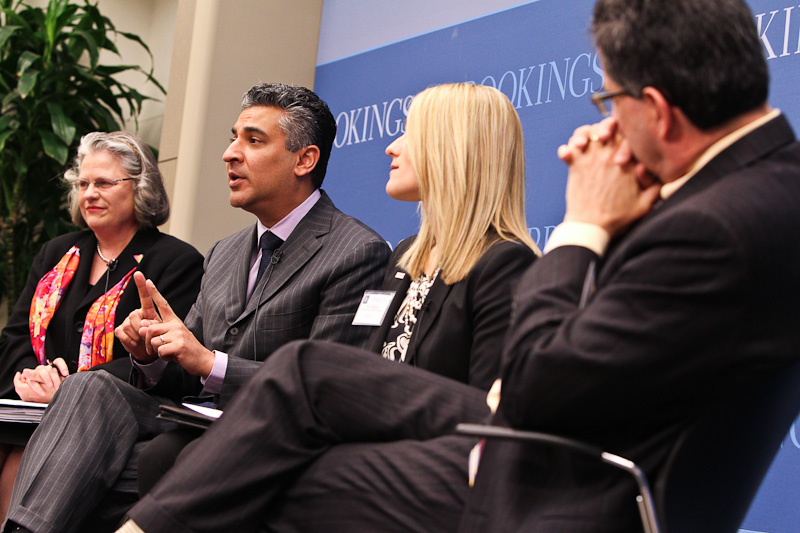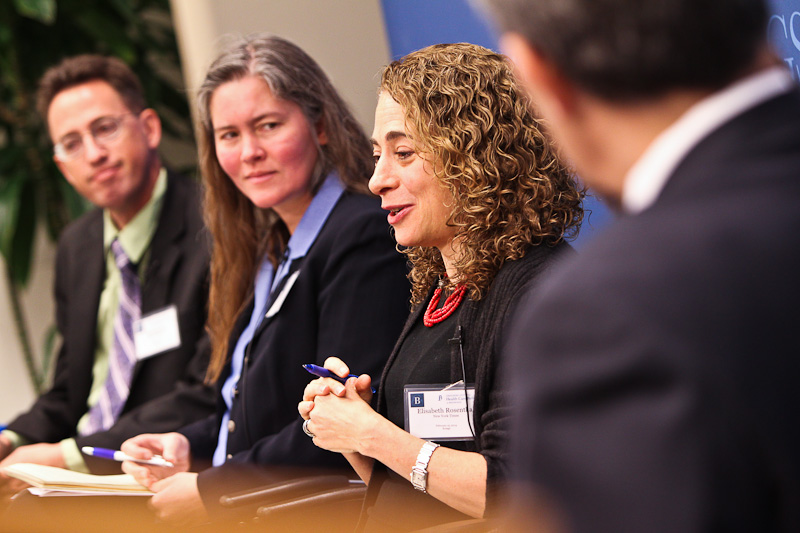As implementation of the Affordable Care Act carries on across all corners of the health care industry, and touches lives in communities throughout the U.S., the need to ensure that clinicians and health care consumers are receiving the information and resources necessary to achieve these reforms has become increasingly urgent. On February 19th, the Engelberg Center for Health Care Reform at Brookings hosted the second in a series of briefings that explore new ways to engage clinicians, patients, and consumers in health reform efforts, including a special focus on the emerging role of traditional media, social media, and massive open online courses (MOOC).
As an effort of the Institution’s Merkin Initiative on Payment Reform and Clinical Leadership, led by Brookings fellow, Darshak Sanghavi, the event featured four panel discussions and over a dozen leaders representing health policy, physician and medical student professional societies, technology, education, and media. The event also signified the launch of a new partnership with the Khan Academy, a nonprofit dedicated to providing a free world-class education for anyone, anywhere, and reaches an estimated 10 million users per month. The Merkin-Khan Academy includes a series of free, online education tutorials about the U.S. health care system, including the role of health insurance, prescription drugs, delivery of care, and health reform.
During the event, Sal Khan, founder of the Khan Academy introduced the partnership and the tutorials, and Rishi Desai, Khan Academy’s health expert spoke about the importance of including health care topics as part of Khan’s interactive learning style.
Explore the Merkin-Khan Academy “Intro to the Health Care System.”
 The first panel titled “Why Clinicians are Confused about Payment and Delivery Reform” included Howard Bauchner, Journal of the American Medical Association (JAMA); Lois Nora, the American Board of Medical Specialties (ABMS); Atul Grover, Association of American Medical Colleges; and Nida Degesys, the American Medical Student Association (AMSA). The panel focused on the existing gap in communication and knowledge- sharing about “health reform in practice” among medical students, residents, and even clinicians already in the workforce. The panel cited a number of challenges, including significant cultural shifts in medicine, such as workforce shortages, the transition from a ‘physician as quarterback’ model to an interprofessional team model. Both will have significant implications for the success of delivery reforms and new payment models. The panel emphasized opportunities to close this gap by incorporating health policy into graduate medical education and board certification, and providing more accessible learning opportunities throughout a clinician’s career via social media, traditional media, and online education. However, all the panelists recognized that taking on health policy will be a difficult addition to an already daunting medical education.
The first panel titled “Why Clinicians are Confused about Payment and Delivery Reform” included Howard Bauchner, Journal of the American Medical Association (JAMA); Lois Nora, the American Board of Medical Specialties (ABMS); Atul Grover, Association of American Medical Colleges; and Nida Degesys, the American Medical Student Association (AMSA). The panel focused on the existing gap in communication and knowledge- sharing about “health reform in practice” among medical students, residents, and even clinicians already in the workforce. The panel cited a number of challenges, including significant cultural shifts in medicine, such as workforce shortages, the transition from a ‘physician as quarterback’ model to an interprofessional team model. Both will have significant implications for the success of delivery reforms and new payment models. The panel emphasized opportunities to close this gap by incorporating health policy into graduate medical education and board certification, and providing more accessible learning opportunities throughout a clinician’s career via social media, traditional media, and online education. However, all the panelists recognized that taking on health policy will be a difficult addition to an already daunting medical education.
Learn more about the challenges and opportunities that clinicians are facing (Video 43:45)
 The second panel titled “How Can We Better Explain Payment and Delivery Reform?” brought together an accomplished group of media experts, including Richard Besser, ABC News; Phil Galewitz, Kaiser Health News; Joanne Kenan, Politico; Laura Helmuth, Slate; and Elisabeth Rosenthal, The New York Times. The panel provided fascinating insights about recent efforts to shed light on public health and health policy issues. All panelists agreed that neither is considered newsworthy unless hooked to a personal narrative or political conflict, which resulted in new ways of approaching the topics. For example, Elisabeth Rosenthal discussed her series on health care costs by the featuring a reader’s experience in ‘shopping’ for a hip replacement. Laura Helmuth cited one of the most read health care articles on Slate used a “top 10 list” bit to explain the intricacies of Obamacare to health care consumers.
The second panel titled “How Can We Better Explain Payment and Delivery Reform?” brought together an accomplished group of media experts, including Richard Besser, ABC News; Phil Galewitz, Kaiser Health News; Joanne Kenan, Politico; Laura Helmuth, Slate; and Elisabeth Rosenthal, The New York Times. The panel provided fascinating insights about recent efforts to shed light on public health and health policy issues. All panelists agreed that neither is considered newsworthy unless hooked to a personal narrative or political conflict, which resulted in new ways of approaching the topics. For example, Elisabeth Rosenthal discussed her series on health care costs by the featuring a reader’s experience in ‘shopping’ for a hip replacement. Laura Helmuth cited one of the most read health care articles on Slate used a “top 10 list” bit to explain the intricacies of Obamacare to health care consumers.
Learn more about the media strategies being used today.
Building on the conversation to develop new ways to communicate with clinicians, the final panel Using Social Media to Spark Clinician Led Change in Health Care included several physicians and patient activists who are active social media users, including Kavita Patel, Brookings; e-Patient Dave, “e-Patient Dave Blog;” Neel Shah, Costs of Care Project; and Alice Chen, Doctors for America. The panelists agreed that social media can be a powerful tool to create a sense of community, not only for providers, but also for patients who are facing challenges in the health care system. Neel Shah of “Costs of Care” started his blog and crowd sourced frontline stories from physicians, nurses, and patients across the country. Similarly, Alice Chen of Doctors for America has brought physicians together to discuss how to change the health care system. While patients and providers are highly motivated to change the system, educating each other and exchanging ideas about how to accomplish that will be critical. Blogs, Twitter, and other online resources are becoming an essential venue for this community building and knowledge exchange.
Learn more about social media resources for providers and patients here.
While the media is important for educating clinicians about the basics of health reform, they cannot always get the details they need from these sources. Massive Open Online Courses (MOOCs), such as those provided by edX, are one resource that clinicians can use to learn about the intricacies of payment and delivery reform. As Anant Agarwal noted, edX is using technology to increase access to and improve the quality of education across the world. Through MOOCs, the Merkin Initiative can build upon the fundamentals taught in the Khan videos to educate clinicians about how to change their encounters at the patient level.
The Brookings Institution is committed to quality, independence, and impact.
We are supported by a diverse array of funders. In line with our values and policies, each Brookings publication represents the sole views of its author(s).



Commentary
Inspiring a Generation of Leadership: Clinicians, Health Reform, and the Role of New Media
February 25, 2014